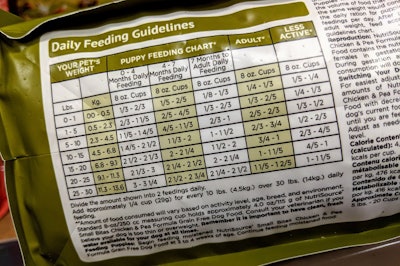
A concerted effort to modernize pet food labels in the U.S. has been under way for several years now. Begun by a committee within the Pet Food Institute with the intent to shape potential new regulations called for under the Food and Drug Administration Amendments Act (FDAAA, passed in 2007 after the massive melamine-related pet food recalls), the pet food labeling update initiative is now being actively pursued by the Pet Food Committee of the Association of American Feed Control Officials.
Though the FDAAA regulations have never come to pass, most likely because some proposed elements ended up being superseded by FDA’s new regulations under the Food Safety Modernization Act, other components like updated pet food labeling standards have never gone away. And for good reason. I think most people in the industry would agree that pet food labels, including the regulations tied to them, have not even come close to keeping up with the industry’s evolution, especially in the areas of pet food product development, novel ingredients and various consumer trends.
In addition, consumer surveys have repeatedly shown that most pet owners find pet food labels to be confusing, overwhelming and generally unhelpful.
Pet owners want more information on pet food labels
Case in point: A new survey conducted by Luminer, a packaging printer and converter, indicated 92 percent of consumers read the ingredients list when buying a new pet food, yet 84 percent said they would be more likely to read pet food labels overall if they provided more nutrition and ingredient information. Further, packing and nutritional information was the top factor significantly affecting pet food purchasing decisions, at 42 percent, while 41 percent of respondents said the label not providing enough information makes them less likely to buy that product.
Unfortunately, Luminer did not provide any information on the survey itself – how it was conducted, the number of consumers involved or any of their demographics (such as where they reside) – but the findings are consistent with that of other, similar surveys.
Yet knowing and acknowledging that consumers want more information on pet food labels, or even the types of information they want, doesn’t always jibe with what current regulations require or allow. And even though the label modernization concepts being developed are trying to resolve some of those conflicts, there’s the matter of physics: Pet food packages have only so much space to display information, particularly as package sizes continue to decrease.
Would new label types and technological advances help?
In its blog post reporting on the survey, Luminer attempts to address this problem. “Today’s labeling constructions and technological advances mean that there are numerous ways to achieve these goals, ensuring that both marketing information and required regulatory information can live together on packaging labels in a harmonious and effective manner,” it says.
Then Luminer provides examples under the category of “expanded content labels,” including booklet, fold-out and peel-reseal labels, which, naturally, the company offers. These types of labels, it says, “can provide a clean way to incorporate a lot of information in a small amount of physical package space.”
Perhaps, but: Having tried such labels myself on other products, such as cosmetics, I can report that sometimes they provide a test of wills and determination. Being a diehard label reader, I’ve spent several minutes doggedly trying to grab the corner of a peel-and-reseal label to reveal its ingredients panel. Then, when I finally was able to unearth the additional information, the text was so tiny, I could barely decipher it. And Luminer’s own survey identified label text being too small to read as a deterrent for 25 percent of consumers!
Would many other consumers go the lengths I did, even when it comes to their beloved pets’ nutrition? They might, but before pet food brands were to invest in such technology or features, they would have to be proven convenient and viable for consumers to actually use. After all, some brands have QR codes on their packages for consumers to scan to find more information online; are those well used?
And, of course, even with more space available, pet food brands would still need to ensure the additional information provided is helpful to consumers, while complying with regulations. Given that the potential pet food label updates being considered have been in discussion since 2015, it could be a while for such changes to align and hit the market.

















